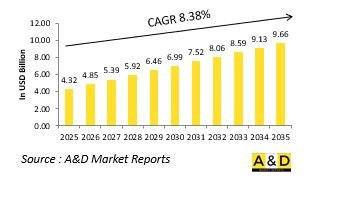
|
市場調査レポート
商品コード
1820812
船舶シミュレータの世界市場:2025-2035年Global Ship Simulator Market 2025-2035 |
||||||
|
|||||||
| 船舶シミュレータの世界市場:2025-2035年 |
|
出版日: 2025年09月24日
発行: Aviation & Defense Market Reports (A&D)
ページ情報: 英文 150+ Pages
納期: 3営業日
|
概要
世界の船舶シミュレーターの市場規模は、2025年の43億2,000万米ドルから、予測期間中は8.38%のCAGRで推移し、2035年には96億6,000万米ドルに成長すると予測されています。

船舶シミュレータ市場の概要:
防衛用船舶シミュレータ市場は、現代の海軍訓練および即応態勢戦略において重要な要素であり、現実的で費用対効果が高く、リスクのない環境を提供することで、要員の訓練や作戦手順の検証を可能にします。船舶シミュレータは現実の海上状況を再現し、乗員が航海、戦闘行動、被害制御、任務計画などを実地訓練に伴う後方支援の負担や高額なコストを負わずに実践できるようにします。これにより、乗員の熟練度を高め、意思決定能力を改善し、複雑な任務に備えることができます。悪天候、戦闘交戦、緊急事態といった状況を再現することで、訓練生は多様な作戦上の課題に対して制御された環境で対応経験を積むことができます。この没入型訓練アプローチは、事故を大幅に減少させ、安全性を高め、技能習得を加速させます。海軍作戦が高度化するにつれ、統合指揮システム、多艦協調、合同任務部隊シナリオを再現できるシミュレーターの需要が高まっています。さらに、船舶シミュレータはプラットフォーム試験、任務リハーサル、システム評価にも利用され、その戦略的有用性を拡大しています。戦闘即応態勢の維持、作戦効率の向上、継続的な技能開発の支援における役割から、シミュレーターは進化する海上防衛訓練と能力構築の分野において不可欠な資産となっています。
船舶シミュレーター市場における技術の影響:
技術の進歩は、防衛用船舶シミュレータ市場を変革し、これまでにないレベルのリアリズム、没入感、訓練効果を実現しています。高度なグラフィックエンジンや高精度の物理モデリングの統合により、流体力学、船舶挙動、環境変数を含む現実の海上条件を精緻に再現できるようになっています。仮想現実(VR)や拡張現実(AR)の技術は、訓練生に完全にインタラクティブな3D環境とリアルな状況認識を提供し、没入感を高めています。また、AIは適応型訓練シナリオの創出に活用されており、仮想の敵や任務の動態が訓練生の判断に応じて変化することで、現実世界の予測不可能性をより正確に反映しています。ネットワーク化されたシミュレーションシステムは、複数のプラットフォーム、乗員、指揮所が仮想環境で協調的に訓練を行えるようにし、合同作戦や艦隊の複雑な調整演習を再現可能にしています。さらに、クラウドベースのシミュレーションプラットフォームは、遠隔アクセスや継続的な訓練を可能にし、インフラコストを削減しつつ利用範囲を拡大しています。加えて、デジタルツインの統合により、防衛当局は実際の船舶システムや挙動をモデル化し、任務リハーサル、保守訓練、システム試験に活用できるようになっています。これらの革新は作戦即応性を高めるだけでなく、迅速なシナリオのカスタマイズやデータに基づくパフォーマンス評価も可能にし、現代のシミュレーターを次世代の海軍訓練および任務計画能力の重要な基盤としています。
船舶シミュレータ市場の主な推進要因:
防衛用船舶シミュレータ市場の成長は、訓練の優先順位、技術導入、戦略的即応性の変化を反映する複数の要因によって推進されています。海軍作戦の複雑化や高度な戦闘システムの統合は、高度に熟練した要員を必要とし、そのため洗練されたシミュレーションベースの訓練ソリューションへの需要が高まっています。費用対効果やリスク低減への関心の高まりも、防衛機関がシミュレーターを実地訓練の安全で経済的な代替手段として採用する要因となっています。また、相互運用性や合同任務の調整の重要性が高まる中、複数プラットフォームの作戦を再現できるネットワーク型シミュレーション環境の開発が進められています。さらに、自律システム、サイバー戦能力、統合戦闘ネットワークなどの海軍技術の急速な進展は、進化する作戦環境を反映した最新の訓練ツールを必要としています。乗員の熟練度を維持するための継続的な学習や任務リハーサルへの注力も、シミュレーターの役割を広げています。各国の防衛近代化プログラムや訓練インフラへの投資増加も需要を後押ししています。船舶シミュレータは、戦略的意思決定を支援し、訓練時間を短縮し、任務成功率を高めることができるため、現代の海上防衛戦略における海軍即応性と作戦効率の強化に不可欠なツールとして位置づけられています。
当レポートでは、世界の船舶シミュレータ市場を調査し、市場背景、市場影響因子の分析、市場規模の推移・予測、各種区分・地域別の詳細分析などをまとめています。
目次
船舶シミュレータ市場レポートの定義
船舶シミュレータ市場セグメンテーション
地域別
タイプ別
エンドユーザー別
今後10年間の船舶シミュレータ市場の分析
船舶シミュレータ市場における技術
世界の船舶シミュレータ市場の予測
船舶シミュレータ市場の動向・予測:地域別
北米
促進要因、制約、課題
PEST
市場予測とシナリオ分析
主要企業
サプライヤー階層の情勢
企業ベンチマーク
欧州
中東
アジア太平洋地域
南米
船舶シミュレータ市場の国別分析
米国
防衛プログラム
最新ニュース
特許
この市場における現在の技術成熟度
市場予測とシナリオ分析
カナダ
イタリア
フランス
ドイツ
オランダ
ベルギー
スペイン
スウェーデン
ギリシャ
オーストラリア
南アフリカ
インド
中国
ロシア
韓国
日本
マレーシア
シンガポール
ブラジル


